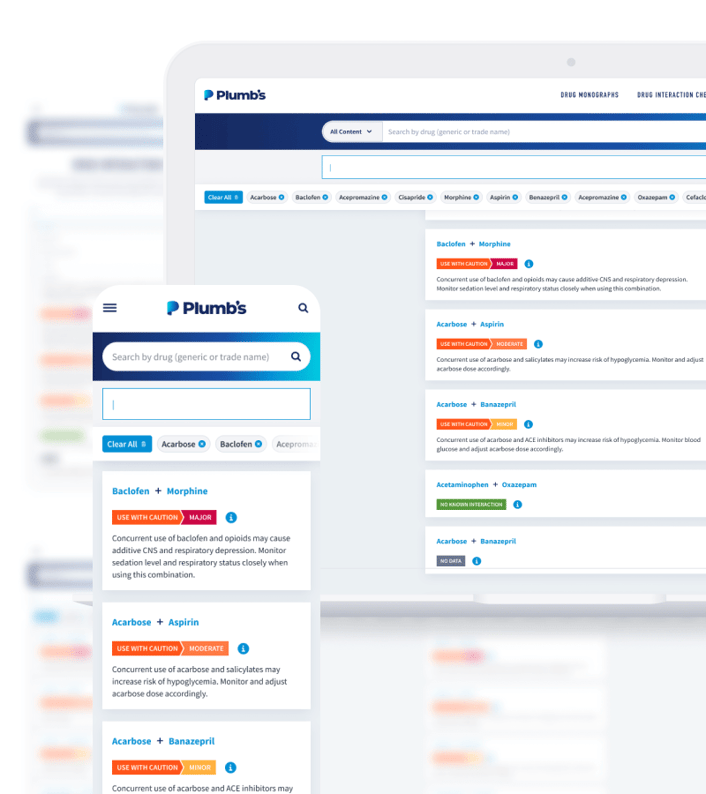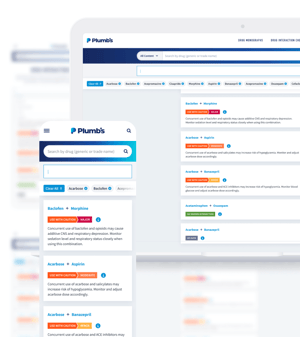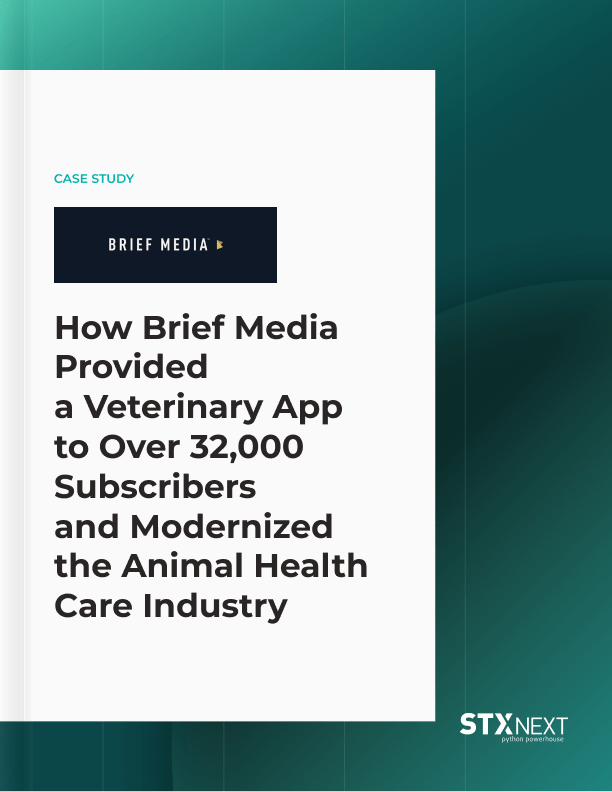

VetMedux is a leading veterinary media company based in Oklahoma, USA. They provide resources to help veterinarians in their day-to-day life. They are US-focused and primarily support the clinicians of small animals: dogs, cats, and other household pets.
In 2014, VetMedux partnered with Plumb’s Veterinary Drugs—a handbook that has become a trusted resource for veterinarians since it was first published in 1991. The guide is widely used across the veterinary industry in the USA.
The Plumb’s Veterinary Drugs app and website first launched in 2015 and has four key user groups:
As well as providing drug information through Plumb’s, VetMedux also publishes advertiser-supported clinical articles.
Many veterinarians rely on Plumb’s Veterinary Drug Handbook on a daily basis. The handbook helps them when they are prescribing medication and helps them to feel confident in their dosage.
The information included in the book has been steadily increasing. By the time the ninth edition was published, it comprised almost 1,500 pages and weighed more than 2.5 kilograms. It had become apparent that the guide needed to change.
The physical copy had drawbacks other than its size: often, practices would only have one copy shared between different veterinarians which can lead to unnecessary delays if people need to spend time tracking it down.
A printed book, once published, is unable to be updated until a new edition is released. In the case of Plumb’s Veterinary Drug Handbook, this was typically every three or four years.
Once VetMedux had obtained the right to use Plumb’s content, they were tasked with digitizing a huge amount of information—and presenting it in an accessible and user-friendly way.
From a business perspective, VetMedux’s main challenge was to stand out in a very competitive market. The aim was to create the most popular professional app for veterinarians in the USA.
VetMedux wanted to provide an original and unique product based on a cornerstone of animal healthcare in the US. The product would be an extension of the legacy already created by the physical version of Plumb’s Veterinary Drug Handbook.
VetMedux had taken on the task of creating an app that would reflect the existing paper guide: a platform that offered support to veterinary professionals and could be trusted as a reliable resource.
The Plumb’s Veterinary Drugs website and app (iOS and Android) were first launched in 2015. The product had originally been outsourced to a company within the USA, but over time had encountered a number of difficulties.
Primarily, the technology aged and the product was not as stable as required by 2019. There were some reliability issues and difficulties updating content.
Due to these challenges, development for the website and app was brought back in-house. However, it soon became clear that what VetMedux wanted required more work than the in-house team could manage on top of their existing workload.
VetMedux decided to approach STX Next, who had been on their radar thanks to recommendations from two different sources.
Originally, VetMedux looked into working with us solely on Plumb’s Pro: an expanded version of the original Plumb’s platform that would offer more functionalities to Pro subscribers. Research had shown VetMedux this product was desperately wanted within stxnext.com 4 the veterinary industry and has no direct alternative. Plumb’s Pro would allow practices to function more easily.
After the discovery workshop, VetMedux decided that they want to work with STX Next on the basic version—not just Plumb’s Pro. It was thought that better solutions could also be found for the basic product.
At the start of the collaboration between VetMedux and STX Next, there was already an existing Plumb’s platform.
In May 2020, we held a discovery workshop with VetMedux to understand the project in greater detail. During these workshops, a rough backlog was created. We estimated when the deliverables could be provided and how many developers would be involved.
After a kick-off meeting, a few weeks were spent conducting further workshops and interviews to really dig deep into the project.
Dr. Amy Mohl from VetMedux was impressed by what the workshops offered.
Chief Medical Officer, VetMedux
As well as setting out the user journey and identifying the pain points, we presented original potential ideas that the client had not considered.
Chief Medical Officer, VetMedux
We came away with eight deliverables, helping us leverage their expertise from a business perspective. We came away with requirements, a road map, recommendations on the system architecture, concept design, and prototype. Then they gave us an estimate for team composition needed to develop the platform.
This helped with product management. They also assessed how we could balance our business interests with providing the most value to the end-user subscriber.”
Chief Information Officer, VetMedux
Alongside the workshops, our team organized a “magic estimation session,” which was important to the project. At the very beginning of the project Przemysław Kusiakiewicz, the Product Owner, invited all developers to take part in the session as a way to understand what the whole project would involve and set out realistic initial timeframes.
What came out of the magic estimation session was used as a basis for discussion with other stakeholders. It allowed the stakeholders to see the time and effort required to build different parts of the product, to make decisions about what to keep in the backlog and what to throw out.
From the start of the project, there was working code from the existing app. But it became apparent that the legacy app should be replaced with a product built with original code.
Our job was to provide a better version of a good product. There was no problem with the content within the web app—but there was room for improvement with the web app itself. The app that we were presented with was not necessarily intuitive and had stability issues. There was scope for the original product to be refreshed and updated.
“The biggest challenge was related to the application before. The challenge was to migrate the old project to new technologies,” says Mariusz Sobczak, Senior Full-Stack Developer at STX Next.
Rebuilding the product with new code was the best solution to ensure our developers could follow best practices, speed up development, and ensure high-quality code.
We kept the initial architecture and expanded it. AWS (Amazon Web Services) was used on the backend—which is a strong backbone for the product.
Applications were created using the Python framework Django, MySQL database, and Elasticsearch engine.
“You could create your own code from the beginning with people you work with—not make changes to old code from other developers,” says Romana Ciesielska, who progressed to a Regular+ Developer position on the VetMedux project. “It was the perfect project to develop my technical skills and soft skills—with so many developers on one team, it was a chance to learn in my own time.”
Becca Thompson, Senior Project Manager, Engineering, at VetMedux, explains the positive impact that the new version has had on their users, their employees, and their overall business:
There is the other side as well, which is the content perspective of being able to make an update to content and release it and it immediately happens. That’s been amazing.
I know that our content team has been so much happier with the processes and the ease of being able to make changes or add content and they don’t have to do any weird workarounds, they can do it themselves. They were previously having to work with the development team a lot. So I think from a workflow perspective, things are working smoother as well.”
Senior Project Manager, Engineering, VetMedux
The directive from VetMedux was that they wanted to create an industry-changing product with a technical focus on four key areas:
The product, which is a serverless application, was built using AWS (Amazon Web Services) and the whole infrastructure was kept in code. AWS also helped fulfill the availability, monitoring, security, and scalability requirements.
The code base for the infrastructure configuration is customized for the specific client and their requirements. For VetMedux, we decided that the frontend would be served on Amazon CloudFront rather than a standalone virtual machine.
CloudFront serves the static website hosted on S3. This ensures high availability and is easy to maintain. We only need to make sure that code is properly deployed to S3 and everything will be maintained by the AWS service.
CloudWatch is used to monitor everything in our infrastructure that happens in the application. There has also been a 24/7 DevOps on-call service: our DevOps team ensures the smooth running of the website and app by being available around the clock and reacting to any issues that may arise. Python developers were also on call 24 hours a day at the launch of the web app.
Senior Project Manager, Engineering, VetMedux
Security is always a significant concern for STX Next and our clients. Throughout this project, we have ensured that we have consistently maintained a high-level of security.
On the backend, the Amazon ECS (Elastic Container Service) API has been configured to ensure autoscaling. In case of increased traffic, the service adds resources and sets up a new container that will take over the additional traffic. On the whole, everything is deployed continuously without manual steps.
Our Product Design team worked to make the flow and structure smoother, easier, and more user-friendly. The digital product needed to offer veterinarians everything they had in the physical copy of the Plumb’s handbook—and more.
Using the paper version, you are able to personalize your copy by making notes in the margin and adding comments for your own benefit. At the beginning of the project, users could add notes, but not add comments to a specific paragraph. This was one area where the physical copy had an advantage over the app. We made it possible to add specific comments to specific paragraphs and provided a way that users could migrate the notes they already had to an updated version of the app.
Another big improvement for users of the app was a change from a basic search function (with no tips) to an elastic search. The whole development team worked on the elastic search which allows users to search data on the platform far more easily.
Feedback for the design was positive:
Chief Medical Officer at VetMedux
There has been one key factor that has been crucial in ensuring that this partnership was a success: communication.
Senior Project Manager, Engineering, VetMedux
Of course, communication is a two-way street, and departments across STX Next praised VetMedux for great communication on their part. “They were really responsive and really open to discussing problems,” says Jan Latour, React Native developer.
Chief Information Officer, VetMedux
As well as strong communication skills, VetMedux was also open to different ideas and new ways of working.
Senior Project Manager, Engineering, VetMedux
A good example of new solutions being adopted is the drug interaction checker. Certain medication reacts differently in combination with other drugs. This tool allows veterinarians to see potential conflicts by keeping a record of around 35,000 drug interactions.
Previously, updating their drug interaction checker was a time-consuming process that involved multiple back and forth communications between the doctor and the developers.
We refined the process and removed the need for those back and forth communications. Now, the doctor uses a content management tool to add, edit and preview the drug interactions.
This new way of working is easier and more secure. Simplifying the process and making it more efficient means that there is a significant improvement in what a doctor can do in the hours she works.
From the beginning of the project, VetMedux could see the positives in using the Agile methodology. Their internal development team had already been using Scrum since 2015. However, some team members at VetMedux had limited practical experience using Agile. We saw this as an opportunity to improve their software development velocity for all future projects.
Dioniza Smura, the Senior Scrum Master on the project, organized an introduction to Scrum through an online presentation. Dioniza, who has previously worked as a Product Owner and Project Manager, explained how an Agile approach works. She also showed the benefits of Agile against a traditional Waterfall model of working including having clearer time estimations and more control over the whole project.
We developed the app in one-week sprints and at each demo meeting, we showed a burnup chart which showed the progress of the project and the time needed to deliver further elements of the product.
This project involved a complete overhaul of the product we were originally presented with. Meeting client requirements and ensuring a quality product involved a range of services and specialisms.
Workshops provided a full exploration of what was required on both the frontend and the backend. Our Product Design team focused on creating an optimal user experience, which was a major consideration throughout development. This was a sophisticated project, therefore DevOps were essential to the smooth running of the website and app.
Here is a list of the services that were provided during this project:
As of the start of 2022, the cooperation between STX Next and VetMedux is still ongoing. We continue to work very closely together.
2021 saw the launch of Plumb’s Pro. VetMedux have been responsible for bringing innovative new tools to the market. Tools like the veterinary industry’s first drug interaction checker to focus solely on animals. With Plumb’s Pro, VetMedux continues to grow and support the animal health care industry.
This is what our medical team desperately wants in our practice so when we’re able to get this in the hands of users we’re going to make veterinarians’ lives easier—which is our ultimate goal. We’re going to allow practices to function more efficiently which helps all parts of the business. And from the VetMedux business perspective, this is such a huge growth opportunity for our business.”
Chief Medical Officer at VetMedux
Chief Operating Officer, VetMedux
Chief Medical Officer, VetMedux
Senior Project Manager, Engineering, VetMedux
If you’re building a software product but don’t have the technical capacity, STX Next can provide external talent for your software project—and help you just like we’ve helped VetMedux.
Whether adding developers to your in-house staff or organizing a fully autonomous team to work parallel to your company, 500+ passionate individuals are ready to supercharge your project with extraordinary code.
Launched in 2005, STX Next has grown into the largest Python software development company in Europe. Specializing in Python, JavaScript, and React Native, STX Next is home to over 350+ skilled developers who are supported by a network of Scrum Masters, Product Owners, DevOps, Engineers, Machine Learning, and Data Engineering specialists, and Service Delivery Managers.
We also have an experienced Product Design Team to provide design solutions throughout the development process and help build outstanding digital products. We’ve created marketplaces, internal deployment tools, community platforms, and much more for clients like Mastercard, Unity, or Decathlon.
We have:
We can take your product from a vague concept all the way to launch, then keep growing it with you using industry best practices and technological innovations.
Head over here to contact us and tell us about your project!
Speed up work on your software projects and outpace the competition.
